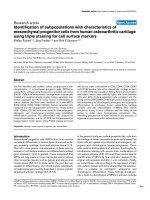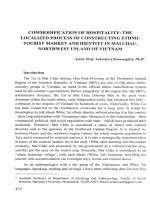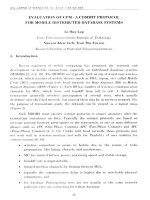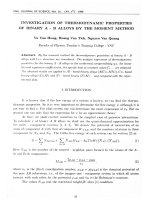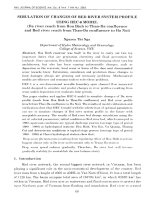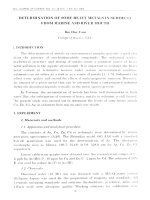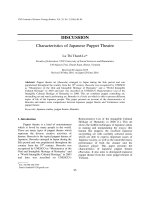DSpace at VNU: Isolation of endothelial progenitor cells from human adipose tissue
Bạn đang xem bản rút gọn của tài liệu. Xem và tải ngay bản đầy đủ của tài liệu tại đây (3.34 MB, 8 trang )
Biomedical Research and Therapy 2016, 3(5): 645-652
DOI 10.7603/s40730-016-0024-6
ISSN 2198-4093
www.bmrat.org
ORIGINAL RESEARCH
Isolation of endothelial progenitor cells from human adipose tissue
Phuc Van Pham1,2,*, Ngoc Bich Vu1, Hoa Trong Nguyen1, Ngoc Kim Phan1,2
1
Laboratory of Stem Cell Research and Application, University of Science, Vietnam National University, Ho Chi Minh city, Vietnam
Faculty of Biology-Biotechnology, University of Science, Vietnam National University, Ho Chi Minh city, Vietnam
*
Corresponding author:
2
Received: 20 April 2016 / Accepted: 21 May 2016 / Published online: 27 May 2016
©The Author(s) 2016. This article is published with open access by BioMedPress (BMP)
Abstract— Adipose tissue is a rich source of stem cells, especially mesenchymal stem cells (MSCs). This study
aimed to identify and isolate endothelial progenitor cells (EPCs) from human adipose tissue. Belly adipose tissues
were collected from donors with consent. Stromal vascular fractions (SVFs) were extracted from adipose tissues by
enzyme collagenase using commercial kits. SVFs were cultured in MSCCult medium for 24 h to obtain MSCs, then
supernatant was collected and cell pellet cultured in EGM-2 medium to obtain adipose tissue EPCs (ADEPCs).
ADEPCs were checked for surface marker expression of CD31 and VEGFR2, and for angiogenesis capability in vitro.
The results showed that SVFs contained a pool of EPCs with strong angiogenesis potential and that adipose tissue is
not only a source for MSCs but also for EPCs. Therefore, ADEPCs may a useful source of EPCs for vascular
medicine.
Keywords: Endothelial progenitor cells,Adipose tissue, Stromal vascular fraction, Stem cells.
INTRODUCTION
Diseases related to ischemia have gradually increased
in recent years. There have been many therapeutic
efforts to treat ischemic heart diseases, including
surgery (angioplasty, stents, atherectomy, etc.) to
medications (beta-blockers, blood thinners, diuretics,
etc.) (Imai et al., 2016; Kang et al., 2016; Lukasiewicz,
2016; von Segesser et al., 2016). Stem cell
transplantation is a candidate therapy that has
recently been tested to treat ischemia-related diseases,
such as stroke (Kasahara et al., 2016; Vahidy et al.,
2016; Wang et al., 2016), heart infarction (Henry et al.,
2016; Li et al., 2016; Winters et al., 2016), and hindlimb
ischemia (Kishimoto et al., 2016; Shin et al., 2016;
Yoshida et al., 2016). There are two kinds of stem cells
mainly used in transplantation studies; these include
mesenchymal stem cells (MSCs) and endothelial
progenitor cells (EPCs). MSCs are considered to be
differentiated from mesoderm; they have shown to be
of benefit in transplanted patients, leading to patient
improvement (Lin et al., 2016; Yuan et al., 2016).
EPCs are another group of important stem cells; they
exhibit strong angiogenesis potential and play a key
role in vasculogenesis and angiogenesis (Chong et al.,
2016). EPCs have been used effectively to treat
hindlimb ischemia (Flex et al., 2016; Yu et al., 2015),
stroke (Bai et al., 2015; Li et al., 2015), diabetic ulcer
(Barcelos et al., 2009; Tam et al., 2015), and myocardial
infarction (Mehmood et al., 2015; Sheng et al., 2015).
However, the greatest limitation of EPC-based
transplantation is the scarcity of EPCs; unlike other
stem cells, EPCs exist in umbilical cord blood (Finney
et al., 2006; Lin et al., 2011; Moon et al., 2013; Phuc et
al., 2012), bone marrow (Ii, 2010) and peripheral blood
(Donndorf et al., 2015), with extremely low numbers,
and have slow proliferation in vitro. To overcome
these limitations, our study is aimed at isolating and
culturing EPCs from adipose tissue, as an alternative
primary source.
Compared to adipose tissue-derived stem cells
(ADSCs) that have been studied longer, adipose tissue
derived EPCs (ADEPCs) have only recently been
Endothelial progenitor cells from adipose tissue
645
Pham et al., 2016
Biomed Res Ther 2016, 3(5): 645-652
investigated and reported in the literature. There has
been some controversy regarding EPCs from adipose
tissue. Initially, studies showed that adipose tissue
could be broken down into stromal vascular fractions
(SVFs); in fact, SVFs were thought to be the
mononuclear cells from adipose tissue. However, it
was later demonstrated that SVFs actually contained
stem cells which could differentiate into various
lineages, including fibroblasts, adipocytes, pericytes,
osteoblasts, chondrocytes and myocytes (Miyazaki et
al., 2005; Zuk et al., 2001). Recently, cultured SVFs was
reported to contain adipose-derived stem/progenitor
cells (ASCs or ADSCs) or adipose- derived
regenerative cells (ADRCs). ADSCs have been proven
to be MSCs, or to exhibit the minimal criteria for MSC
lineage, as suggested by Domicini et al. (Dominici et
al., 2006).
procedure was performed according to the
manufacturer’s instructions. Briefly, two syringes of
aspirated fat were connected with 2 syringes of the
Rapid kit. The syringes were put into an extraction
machine with the following parameters: time: 30 min,
speed: 1 cycle/min. The lysed fat was then centrifuged
at 1000 g for 5 min at room temperature to collect
SVFs. Finally, SVFs were washed twice with
phosphate buffered saline (PBS). The pellet was
resuspended in PBS for determination of cell quantity
and viability using an automatic cell counter
(NucleoCounter; Chemometec, Denmark).
Primary culture
MATERIALS AND METHODS
Three SVF samples were used to isolate EPCs by a 2step procedure. In the first step, SVF samples were
cultured in MSCCult medium (RegenMed Lab, HCM,
Vietnam) containing DMEM/F12 supplemented with
antibiotic-antimycotic, epidermal growth factor (EGF),
basic fibroblast growth factor (bFGF), with 10% FBS
(Thermo-Scientific, MA). The cells were plated at 5 ×
104 cells/mL in T-75 flasks (SPL, Korea) and incubated
at 37°C with 5% CO2 to collect rapidly adherent cells.
After 48 h, the supernatant was collected. In the
second step, the supernatant was centrifuged at 1000 g
for 5 min to harvest the cell pellet. The pellet was
resuspended in EGM-2 solution from the EGM-2
BulletKit (Lonza, Basel, Switzerland); 3 mL of EGM-2
was used per 3 mL of original supernatant. The
suspension was then incubated at 37°C with 5% CO2
to collect slowly adherent cells, which were
considered to be adipose tissue derived endothelial
progenitor cells (ADEPCs). After 7 d, the cell medium
was replaced with fresh medium, and continually
replaced every subsequent 3 d until the cells reached
70–80% confluence. At that point, the cells were subcultured by TrypLe Express (Thermo-Scientific, MA).
Adipose tissue collection
Flow cytometry
All patients enrolled in this study were required to
sign a consent form. All procedures used in the study
were approved by the ethical committee of the
hospital. Three adipose tissue samples were used in
this study. Approximately 50–100 mL of lipoaspirate
was collected from each patient in two 50 mL sterile
syringes.
Cell markers were analyzed following a previously
published protocol. Briefly, cells were washed twice in
PBS containing 1% bovine serum albumin (BSA). The
cells were then stained with anti-CD31-FITC and antivascular endothelial growth factor receptor 2 (antiVEGFR2)-PE (both purchased from Santa Cruz
Biotechnology, Canada) for ADEPCs, and anti-CD44PE, anti-CD73-PE, and anti-CD90-FITC (all purchased
from Santa Cruz Biotechnology) for MSCs. Stained
cells were analyzed by a FACSCalibur flow cytometer
(BD Biosciences). Isotype controls were used in all
analyses.
To obtain EPCs for therapy, it has been reported that
ADSCs can differentiate into ECs or EPCs (Miranville
et al., 2004; Planat-Benard et al., 2004; Sumi et al.,
2007). However, some studies have rejected this
notion, and refute that ADSCs can differentiate into
ECs/EPCs (Kondo et al., 2009). Several recent studies
have indicated that adipose-derived regenerative cells
(ADRCs) can differentiate into pericytes in vitro and in
vivo (Amos et al., 2008; Traktuev et al., 2008;
Zannettino et al., 2008). However, transplantation of
ADSCs, as well as SVFs, have demonstrated neoangiogenesis and vasculogenesis in vivo(Guo et al.,
2016; Zhong et al., 2016). Based on these reports, we
hypothesized that ADSCs do not differentiate into
EPCs, but that SVFs may contain an EPC population.
Isolation of SVFs from adipose tissue
SVFs from the adipose tissue (lipoaspirate) in syringes
were collected using the SVF Rapid Kit
(RegenMedLab, HCM, Vietnam). The extraction
Endothelial progenitor cells from adipose tissue
646
Pham et al., 2016
Biomed Res Ther 2016, 3(5): 645-652
Capillary-like structure formation assay
RESULTS
Capillary-like structure formation was done by an
angiogenesis starter kit (Life Technologies, Carlsbad,
CA, USA). Briefly, ADEPCs were seeded on 6-well
flat-bottom plates coated with Geltrex Matrix and
Medium 200. Eighteen hours after incubation,
capillary-like structures were observed under an
Axiovert microscope (Carl-Zeiss, Germany).
SVF extraction
Statistical analysis
Significant differences between mean values were
assessed by t-tests and analysis of variance (ANOVA).
A P-value of <0.05 was considered statistically
significant. All data were analyzed by GraphPad
Prism 6 software.
Three samples of adipose tissue were used to isolate
SVFs. The results showed that adipose tissues
contained 1.31±0.27 106 SVF cells with percent viability
of 92.17±5.81%.
SVF culture and proliferation
In the first step, SVFs were cultured in DMEM/F12
medium for 48 h to isolate MSCs. The culture
supernatant was collected and placed in new flasks
with fresh medium (containing EGM-2). After 48 h of
culture, adherent cells appeared in the flasks. After 5
d, these cells rapidly proliferated and formed colonies.
Under the microscope, these colonies (or EPC
candidates) exhibited the characteristic shape of EPCs
(Fig. 1).
Figure 1. EPC isolation from adipose tissue. EPC candidates adhered tothe flask surface after 3 days of culture (A). Some EPC
candidate colonies were formed in the culture (B). And EPCs became a homogenous population after 3 times of sub-culture. A and
B were captured at 10x magnification, and C at 20x magnification.
Expression of CD31 and VEGFR2
Capillary-like network formation in vitro
Expression of CD31 and VEGFR2 on the surface of
EPC candidates were evaluated by flow cytometry
and immunocytochemistry. The results showed that
the majority of AD-EPCs showed high expression of
CD31 and VEGFR2, with 93.31±9.11% and 98.91±1.14%
of the cells staining positive, respectively (Fig. 2F).
ADEPC marker expression was also confirmed by
immunocytochemistry; almost all of the ADEPCs were
positive for CD31 and VEGFR2 (Fig. 2A-D). The
double positive CD31+VEGFR2+ population was also
observed (Fig. 2E).
ADEPCs were assessed for in vitro capillary formation
in Matrigel. As shown in Fig. 3, ADEPCs were capable
of forming capillaries (Fig. 3A, D), similar to human
vein endothelial cells (HUVECs) (Fig. 3B, E), while
MSCs derived from the same samples of SVFs could
not form capillaries (Fig. 3C, F).
Endothelial progenitor cells from adipose tissue
647
Pham et al., 2016
Biomed Res Ther 2016, 3(5): 645-652
Figure 2. EPC candidates were positive with CD31 and VEGFR2. ADEPCs were stained with CD31-FITC (C), with VEGFR2-PE
(D), and counterstained with DAPI for cell nuclei (B). The merged figure showed that these cells co-expressed CD31 and VEGFR2
(E). The expression of CD31 and VEGFR2 also were confirmed by flow cytometry (F). All figures were captured at 20X
magnification.
Figure 3. Capillary-like network formation in vitro of EPC candidates. ADEPCs can formed the capillary-like network when
cultured in the Matrigel (D) compared to normal culture condition (A). This result was similar to HUVECs cultured in Matrigel (E)
compared to adhere culture (B). However, the MSCs obtained from the same sample of adipose tissue could not form capillary-like
network in Matrigel and normal condition (C and F). All figures were captured at 10X magnification.
Isolation of both MSCs and EPCs from same adipose
tissue samples
We were able to isolate both MSCs (ADSCs) and
ADEPCs from the same adipose tissues. In the first
culture (first 24 h), the adherent cells exhibited the
characteristic MSC phenotypes. The cells adhered
tothe flask surface with fibroblast-like shape (Fig. 4A).
They also expressed particular MSC markers, such as
CD44 (98.89±3.12%), CD73 (98.78±1.21%) and CD90
(100%) (Fig. 4B). Although they failed to form
capillary-like network formation in vitro, the cells
could differentiate into osteoblasts, chondroblasts and
adipocytes (Fig. 4C). In fact, after induction with an
osteoblast-inducing medium, the cells stained positive
with alizarin red staining. Moreover, after induction
by chondrogenesis, MSCs stained positive with
Safranin O staining; after induction by adipogenesis,
MSCs were positive with Oil Red staining.
Endothelial progenitor cells from adipose tissue
648
Pham et al., 2016
Biomed Res Ther 2016, 3(5): 645-652
Figure 4. MSCs phenotype and characterization. MSCs from adipose tissue were positive forCD44 (D), CD73 (E) and CD90 (F),
while negative with CD14 (A), CD45 (B) and HLADR (C). These cells also exhibited the fibroblast-like shape (G), successfully
differentiated into adipocytes that were positive with Oil red (H); osteoblasts that were positive with alizarin red (I), chondroblasts
that were positive with Safranin O (K).
DISCUSSION
EPCs are essential stem cells in regenerative medicine
as well as vascular medicine. This study evaluated
adipose tissue as a potential new source for EPCs. The
ADEPCs exhibited phenotypic and functional markers
of EPCs. It has been noted in some previous studies
that EPCs are detected, and only at low numbers, in
umbilical cord blood (Finney et al., 2006; Lin et al.,
2011; Moon et al., 2013; Phuc et al., 2012), bone
marrow (Ii, 2010) and peripheral blood (Donndorf et
al., 2015). These EPCs have been successfully applied
to treat ischemia-related diseases, such as hindlimb
ischemia (Flex et al., 2016; Yu et al., 2015), stroke (Bai
et al., 2015; Li et al., 2015), diabetic ulcer (Barcelos et
al., 2009; Tam et al., 2015), and myocardial infarction
(Mehmood et al., 2015; Sheng et al., 2015).
Although the EPCs from our study were obtained
from a different source (adipose tissue), they exhibited
several common properties of EPCs, including
expression of CD31 and VEGFR2, and capillary-like
network formation in vitro(Finney et al., 2006; Ii, 2010;
Lin et al., 2011; Moon et al., 2013; Phuc et al., 2012).
Expression of CD31 and VEGFR2 was strong after the
3rd cell passage. The cells demonstrated the ability to
form new blood vessels in vitro, similar to HUVECs.
The isolation of EPCs derived from adipose tissue has
been suggested by Planat-Benard et al. (Planat-Benard
et al., 2004). Planat-Benard’s procedure was not
different from standard MSC isolation procedure;
ADEPCs were isolated and proliferated in DMEM/F12
medium supplemented with 10% NCS. Mouse
ADEPCs have been isolated and evaluated in recent
years by Zhou et al (Zhou et al., 2015). Similar to
Endothelial progenitor cells from adipose tissue
649
Pham et al., 2016
Biomed Res Ther 2016, 3(5): 645-652
Planat-Benard et al., Zhou et al. also used DMEM
medium with 10% FBS, without any growth factors or
cytokines. Both of these procedures are similar to MSC
isolation that has been published in the literature
(Cheng et al., 2011; Devitt et al., 2015; Francis et al.,
2010).
In 2014, Navarro et al. showed that there was a cell
population in SVFs exhibiting endothelial cell
properties (Navarro et al., 2014). The fraction of
CD14+ cells contained cells that co-expressed CD45
with some progenitor markers, such as VEGFR2
(KDR), VEGFR1 (Flt1), and Tie2 (Navarro et al., 2014).
These cells also produced VEGF and bFGF at high
levels, compared to MSCs (Navarro et al., 2014).
Our study can be considered as the first study to use
direct cell culture procedures to isolate EPCs from
adipose tissue. The principle for EPC isolation from
SVFs is similar to our previously published study on
isolation of EPCs from umbilical cord blood by cell
culture (Phuc et al., 2012). Based on the different
adherent capacities of MSCs (plastic rapidly-adherent
cells) and EPCs (slowly-adherent), we successfully
isolated MSCs and EPCs from the same samples of
umbilical cord blood mononuclear cells. Similarly, in
this study, the slowly adherent cell population from
SVFs were found to be EPCs, and the rapidly adherent
cells were MSCs.
Abbreviations
ADEPCs:
Adipose
tissue-derived
endothelial
progenitor cells; EPCs: Endothelial progenitor cells;
HUVEC: Human umbilical vein endothelial cells;
MSCs: Mesenchymal stem cells; SVFs: Stromal
vascular fraction; VEGFR2: Vascular endothelial
growth factor receptor 2
Acknowledgments
This work is funded by Vietnam National University,
Ho Chi Minh city, Viet Nam under grant number:
TX2016-18-03.
Competing interests
The authors declare they have no competing interests.
Open Access
This article is distributed under the terms of the Creative
Commons Attribution License (CC-BY 4.0) which permits
any use, distribution, and reproduction in any medium,
provided the original author(s) and the source are credited.
References
CONCLUSION
Previous studies have shown that EPCs are usually
isolated from umbilical cord blood, bone marrow or
peripheral blood, in limited quantity. This study
suggested that a new source of EPCs could be derived
from adipose tissue. The ADEPCs in our study
expressed endothelial cell markers, such as CD31 and
VEGFR2, and formed blood vessels in vitro, similar to
HUVECs. We demonstrated that EPCs can be easily
isolated from adipose tissue by selecting the slowly
adherent cell population from SVFs. These findings
demonstrate the potential and rationale for the use of
adipose tissue for EPC isolation to treat vascular
diseases.
Amos, P.J., Shang, H., Bailey, A.M., Taylor, A., Katz, A.J., and
Peirce, S.M. (2008). IFATS collection: The role of human
adipose-derived stromal cells in inflammatory microvascular
remodeling and evidence of a perivascular phenotype. Stem Cells
26, 2682-2690.
Bai, Y.Y., Wang, L., Peng, X.G., Wang, Y.C., Chang, D.,
Zheng, S., Ding, J., Li, C., and Ju, S. (2015). Non-invasive
monitoring of transplanted endothelial progenitor cells in diabetic
ischemic stroke models. Biomaterials 40, 43-50.
Barcelos, L.S., Duplaa, C., Krankel, N., Graiani, G., Invernici,
G., Katare, R., Siragusa, M., Meloni, M., Campesi, I., Monica,
M., et al. (2009). Human CD133+ progenitor cells promote the
healing of diabetic ischemic ulcers by paracrine stimulation of
angiogenesis and activation of Wnt signaling. Circ Res 104, 10951102.
Cheng, K.-H., Kuo, T.-L., Kuo, K.-K., and Hsiao, C.-C. (2011).
Human adipose-derived stem cells: Isolation, characterization and
current application in regeneration medicine. Genomic Medicine,
Biomarkers, and Health Sciences 3, 53-62.
Chong, M.S., Ng, W.K., and Chan, J.K. (2016). Concise Review:
Endothelial Progenitor Cells in Regenerative Medicine:
Applications and Challenges. Stem Cells Transl Med 5, 530-538.
Endothelial progenitor cells from adipose tissue
650
Pham et al., 2016
Biomed Res Ther 2016, 3(5): 645-652
Devitt, S.M., Carter, C.M., Dierov, R., Weiss, S., Gersch, R.P.,
and Percec, I. (2015). Successful isolation of viable adiposederived stem cells from human adipose tissue subject to long-term
cryopreservation: positive implications for adult stem cell-based
therapeutics in patients of advanced age. Stem Cells Int 2015,
146421.
Dominici, M., Le Blanc, K., Mueller, I., Slaper-Cortenbach, I.,
Marini, F., Krause, D., Deans, R., Keating, A., Prockop, D., and
Horwitz, E. (2006). Minimal criteria for defining multipotent
mesenchymal stromal cells. The International Society for Cellular
Therapy position statement. Cytotherapy 8, 315-317.
Donndorf, P., Lube, L., Lux, C., Skorska, A., Steinhoff, G., and
Kraft, K. (2015). Mobilization of Bone Marrow-Derived
Endothelial Progenitor Cells following Finnish Sauna: A Pilot
Study. Forsch Komplementmed 22, 246-250.
Finney, M.R., Greco, N.J., Haynesworth, S.E., Martin, J.M.,
Hedrick, D.P., Swan, J.Z., Winter, D.G., Kadereit, S., Joseph,
M.E., Fu, P., et al. (2006). Direct comparison of umbilical cord
blood versus bone marrow-derived endothelial precursor cells in
mediating neovascularization in response to vascular ischemia. Biol
Blood Marrow Transplant 12, 585-593.
Flex, A., Biscetti, F., Iachininoto, M.G., Nuzzolo, E.R., Orlando,
N., Capodimonti, S., Angelini, F., Valentini, C.G., Bianchi, M.,
Larocca, L.M., et al. (2016). Human cord blood endothelial
progenitors
promote
post-ischemic
angiogenesis
in
immunocompetent mouse model. Thromb Res 141, 106-111.
Francis, M.P., Sachs, P.C., Elmore, L.W., and E. Holt, S. (2010).
Isolating adipose-derived mesenchymal stem cells from
lipoaspirate blood and saline fraction. Organogenesis 6, 11-14.
Guo, L.Z., Kim, T.H., Han, S., and Kim, S.W. (2016). AngioVasculogenic Properties of Endothelial-Induced Mesenchymal
Stem Cells Derived From Human Adipose Tissue. Circ J 80, 9981007.
Henry, T.D., Schaer, G.L., Traverse, J.H., Povisc, T.J.,
Davidson, C., Lee, J.S., Costa, M.A., Bass, T., Mendelsohn, F.,
Fortuin, F.D., et al. (2016). Autologous CD34<sup>+</sup>
Cell Therapy for Refractory Angina: 2 year Outcomes from the
ACT34-CMI Study. Cell Transplant.
Ii, M. (2010). Bone marrow-derived endothelial progenitor cells:
isolation and characterization for myocardial repair. Methods Mol
Biol 660, 9-27.
Imai, H., Watanabe, K., Miyagishima, T., Yoshimoto, Y., Kin,
T., Nakatomi, H., and Saito, N. (2016). The outcome of a surgical
protocol based on ischemia overprotection in large and giant
aneurysms of the anterior cerebral circulation. Neurosurg Rev.
Kang, W.Y., Campia, U., Ota, H., Didier, R.J., Negi, S.I.,
Kiramijyan, S., Koifman, E., Baker, N.C., Magalhaes, M.A.,
Lipinski, M.J., et al. (2016). Vascular access in critical limb
ischemia. Cardiovasc Revasc Med 17, 190-198.
Kasahara, Y., Yamahara, K., Soma, T., Stern, D.M., Nakagomi,
T., Matsuyama, T., and Taguchi, A. (2016). Transplantation of
hematopoietic stem cells: intra-arterial versus intravenous
administration impacts stroke outcomes in a murine model. Transl
Res.
Kishimoto, S., Inoue, K.I., Nakamura, S., Hattori, H., Ishihara,
M., Sakuma, M., Toyoda, S., Iwaguro, H., Taguchi, I., Inoue, T.,
et al. (2016). Low-molecular weight heparin protamine complex
augmented the potential of adipose-derived stromal cells to
ameliorate limb ischemia. Atherosclerosis 249, 132-139.
Kondo, K., Shintani, S., Shibata, R., Murakami, H., Murakami,
R., Imaizumi, M., Kitagawa, Y., and Murohara, T. (2009).
Implantation of adipose-derived regenerative cells enhances
ischemia-induced angiogenesis. Arterioscler Thromb Vasc Biol 29, 6166.
Li, G.H., Luo, B., Lv, Y.X., Zheng, F., Wang, L., Wei, M.X.,
Li, X.Y., Zhang, L., Wang, J.N., Chen, S.Y., et al. (2016). Dual
effects of VEGF-B on activating cardiomyocytes and cardiac stem
cells to protect the heart against short- and long-term ischemiareperfusion injury. J Transl Med 14, 116.
Li, Y.F., Ren, L.N., Guo, G., Cannella, L.A., Chernaya, V.,
Samuel, S., Liu, S.X., Wang, H., and Yang, X.F. (2015).
Endothelial progenitor cells in ischemic stroke: an exploration
from hypothesis to therapy. J Hematol Oncol 8, 33.
Lin, K.C., Yip, H.K., Shao, P.L., Wu, S.C., Chen, K.H., Chen,
Y.T., Yang, C.C., Sun, C.K., Kao, G.S., Chen, S.Y., et al.
(2016). Combination of adipose-derived mesenchymal stem cells
(ADMSC) and ADMSC-derived exosomes for protecting kidney
from acute ischemia-reperfusion injury. Int J Cardiol 216, 173-185.
Lin, R.Z., Dreyzin, A., Aamodt, K., Dudley, A.C., and MeleroMartin, J.M. (2011). Functional endothelial progenitor cells from
cryopreserved umbilical cord blood. Cell Transplant 20, 515-522.
Lukasiewicz, A. (2016). Treatment of acute lower limb ischaemia.
Vasa 45, 213-221.
Mehmood, A., Ali, M., Khan, S.N., and Riazuddin, S. (2015).
Diazoxide preconditioning of endothelial progenitor cells
improves their ability to repair the infarcted myocardium. Cell Biol
Int 39, 1251-1263.
Miranville, A., Heeschen, C., Sengenes, C., Curat, C.A., Busse,
R., and Bouloumie, A. (2004). Improvement of postnatal
neovascularization by human adipose tissue-derived stem cells.
Circulation 110, 349-355.
Miyazaki, T., Kitagawa, Y., Toriyama, K., Kobori, M., and Torii,
S. (2005). Isolation of two human fibroblastic cell populations
with multiple but distinct potential of mesenchymal differentiation
by ceiling culture of mature fat cells from subcutaneous adipose
tissue. Differentiation 73, 69-78.
Moon, S.H., Kim, S.M., Park, S.J., Kim, H., Bae, D., Choi, Y.S.,
and Chung, H.M. (2013). Development of a xeno-free autologous
culture system for endothelial progenitor cells derived from
human umbilical cord blood. PLoS One 8, e75224.
Navarro, A., Marin, S., Riol, N., Carbonell-Uberos, F., and
Minana, M.D. (2014). Human adipose tissue-resident monocytes
exhibit an endothelial-like phenotype and display angiogenic
properties. Stem Cell Res Ther 5, 50.
Phuc, P.V., Ngoc, V.B., Lam, D.H., Tam, N.T., Viet, P.Q., and
Ngoc, P.K. (2012). Isolation of three important types of stem cells
from the same samples of banked umbilical cord blood. Cell and
Tissue Banking 13, 341-351.
Planat-Benard, V., Silvestre, J.S., Cousin, B., Andre, M.,
Nibbelink, M., Tamarat, R., Clergue, M., Manneville, C., SaillanBarreau, C., Duriez, M., et al. (2004). Plasticity of human adipose
Endothelial progenitor cells from adipose tissue
651
Pham et al., 2016
Biomed Res Ther 2016, 3(5): 645-652
lineage cells toward endothelial cells: physiological and therapeutic
perspectives. Circulation 109, 656-663.
Sheng, Z.L., Yao, Y.Y., Li, Y.F., Fu, C., and Ma, G.S. (2015).
Transplantation of bradykinin-preconditioned human endothelial
progenitor cells improves cardiac function via enhanced
Akt/eNOS phosphorylation and angiogenesis. Am J Transl Res 7,
1214-1226.
Shin, J.Y., Yoon, J.K., Noh, M.K., Bhang, S.H., and Kim, B.S.
(2016). Enhancing Therapeutic Efficacy and Reducing Cell Dosage
in Stem Cell Transplantation Therapy for Ischemic Limb Diseases
by Modifying the Cell Injection Site. Tissue Eng Part A 22, 349-362.
Sumi, M., Sata, M., Toya, N., Yanaga, K., Ohki, T., and Nagai,
R. (2007). Transplantation of adipose stromal cells, but not
mature adipocytes, augments ischemia-induced angiogenesis. Life
Sci 80, 559-565.
Tam, J.C., Ko, C.H., Lau, K.M., To, M.H., Kwok, H.F., Siu,
W.S., Lau, C.P., Chan, W.Y., Leung, P.C., Fung, K.P., et al.
(2015). Enumeration and functional investigation of endothelial
progenitor cells in neovascularization of diabetic foot ulcer rats
with a Chinese 2-herb formula. J Diabetes 7, 718-728.
Traktuev, D.O., Merfeld-Clauss, S., Li, J., Kolonin, M., Arap,
W., Pasqualini, R., Johnstone, B.H., and March, K.L. (2008). A
population of multipotent CD34-positive adipose stromal cells
share pericyte and mesenchymal surface markers, reside in a
periendothelial location, and stabilize endothelial networks. Circ
Res 102, 77-85.
Vahidy, F.S., Rahbar, M.H., Zhu, H., Rowan, P.J., Bambhroliya,
A.B., and Savitz, S.I. (2016). Systematic Review and MetaAnalysis of Bone Marrow-Derived Mononuclear Cells in Animal
Models of Ischemic Stroke. Stroke.
von Segesser, L., Marinakis, S., Berdajs, D., Ferrari, E., Wilhelm,
M., and Maisano, F. (2016). Prevention and therapy of leg
ischaemia in extracorporeal life support and extracorporeal
membrane oxygenation with peripheral cannulation. Swiss Med
Wkly 146, w14304.
Wang, Q., Duan, F., Wang, M.X., Wang, X.D., Liu, P., and Ma,
L.Z. (2016). Effect of stem cell-based therapy for ischemic stroke
treatment: A meta-analysis. Clin Neurol Neurosurg 146, 1-11.
Winters, A.A., Bou-Ghannam, S., Thorp, H., Hawayek, J.A.,
Atkinson, D.L., Bartlett, C.E., Silva, F.J., Hsu, E.W., Moreno,
A.P., Grainger, D.A., et al. (2016). Evaluation of Multiple
Biological Therapies for Ischemic Cardiac Disease. Cell Transplant.
Yoshida, S., Yoshimoto, H., Hirano, A., and Akita, S. (2016).
Wound Healing and Angiogenesis through Combined Use of a
Vascularized Tissue Flap and Adipose-Derived Stem Cells in a Rat
Hindlimb Irradiated Ischemia Model. Plast Reconstr Surg 137, 14861497.
Yu, P., Li, Q., Liu, Y., Zhang, J., Seldeen, K., and Pang, M.
(2015). Pro-angiogenic efficacy of transplanting endothelial
progenitor cells for treating hindlimb ischemia in hyperglycemic
rabbits. J Diabetes Complications 29, 13-19.
Yuan, H., Guan, J., Zhang, J., Zhang, R., and Li, M. (2016).
Exosomes secreted by human urine-derived stem cells accelerate
skin wound healing by promoting angiogenesis in rat. Cell Biol Int.
Zannettino, A.C., Paton, S., Arthur, A., Khor, F., Itescu, S.,
Gimble, J.M., and Gronthos, S. (2008). Multipotential human
adipose-derived stromal stem cells exhibit a perivascular
phenotype in vitro and in vivo. J Cell Physiol 214, 413-421.
Zhong, Z., Gu, H., Peng, J., Wang, W., Johnstone, B.H., March,
K.L., Farlow, M.R., and Du, Y. (2016). GDNF secreted from
adipose-derived stem cells stimulates VEGF-independent
angiogenesis. Oncotarget.
Zhou, L., Xia, J., Qiu, X., Wang, P., Jia, R., Chen, Y., Yang, B.,
and Dai, Y. (2015). In Vitro Evaluation of Endothelial Progenitor
Cells from Adipose Tissue as Potential Angiogenic Cell Sources for
Bladder Angiogenesis. PLoS ONE 10, e0117644.
Zuk, P.A., Zhu, M., Mizuno, H., Huang, J., Futrell, J.W., Katz,
A.J., Benhaim, P., Lorenz, H.P., and Hedrick, M.H. (2001).
Multilineage cells from human adipose tissue: implications for cellbased therapies. Tissue Eng 7, 211-228.
Cite this article as:
Pham, P., Vu, N., Nguyen, H., & Phan, N. (2016).
Isolation of endothelial progenitor cells from human
adipose tissue. Biomedical Research and Therapy, 3(5),
645-652.
Endothelial progenitor cells from adipose tissue
652
